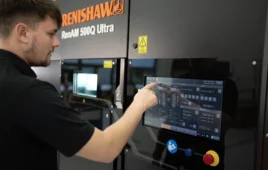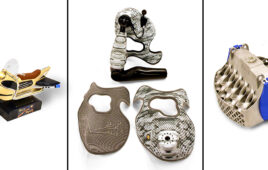By Michael Jermann, Design World Editorial Intern
Most 3D printers use an additive production process where material is deposited on a base and then layered over and over again to create an object. In binder jetting, typically a layer of powder build material is rolled onto a build table. This material is usually either a metal or plastic powder. Then, a binding agent is deposited or jetted in a pattern on a layer of powdered build material. Another layer of build material is then rolled over the first layer, followed by the binder. This process is repeated until the object is completed.
Once built, objects may require additional finishing processes, such as sanding, grinding or chemical treatments to remove excess material, harden the object, or provide a finish coating.
One benefit of any powder-based additive manufacturing method is that the non-bound powder supports overhanging part features from succumbing to gravity. As each layer of powder is deposited, the material not treated with a binding agent acts like a cast for the rest of the object.
Once the object is completed and has had time to set, it is removed from the loose material. Usually this excess material is either dusted off with compressed air or scooped in a vacuum and later returned to the powder bed. Supports located in hard-to-reach areas, though, are more challenging to remove by hand or machine.
In many systems, the loose material can be reused for the next object. Since the loose material completely supports and separates, multiple objects can be stacked or nested in order to maximize the total volume of the printers work space.
Speed is a key benefit of binder jetting. Binder jetting deposits a small portion of the material. This allows for print speeds up to 1.1 inches per hour regardless of object size, shape or number. When comparing 3D printing processes, binder jetting can be up to 10 times fast than other AM processes.
Some binder jetting systems can incorporate colored dyes into the object. This capability allows some printers to print not only in 3D, but also in full color with 90% of the colors in the Adobe Photoshop CMYK color range.
Binder jetted objects are often rigid, holding their shape well over time. With some metal objects, the inherent strength is greater than that of a more pure metal part. Objects are solid and strong, making them great for casting and molding using sand casting, carbon fiber, silicone injection mold and lay-up masters. The high heat tolerances of materials used make them perfect for prototype testing in high temperature environments. The high tolerances of binder jetting machines, typically 0.18 mm, make object made with them suitable for form and fit testing.
Filed Under: Make Parts Fast




